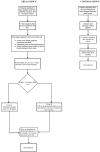Rapid Intervention Through Telephone Encounters for Blood Pressure Control by Residents in an Outpatient Resident Clinic
- PMID: 30338193
- PMCID: PMC6175199
- DOI: 10.7759/cureus.3118
Rapid Intervention Through Telephone Encounters for Blood Pressure Control by Residents in an Outpatient Resident Clinic
Abstract
Introduction Sixty-seven million Americans have hypertensionthat costs the nation $47.5 billion each year. The aim of this study was to determine if regular phone calls by residents helped achieve better blood pressure control. Methods The study was a randomized open-labeled study in a resident-run outpatient clinic in Rochester, New York. A total of 57 poorly controlled hypertensives in the clinic were divided into two groups. All the patients received scheduled phone calls once every two weeks for a total of 24 weeks. In one group, the medications were adjusted over the phone and the other group was referred to be seen in the clinic for elevated blood pressures. Both the groups were compared to the usual standard of care group. Results Fifty-eight patients were recruited for the trial out of which 53 were used for the final data analysis. Eleven patients completed the trial and had a mean drop of systolic blood pressure (SBP) and diastolic blood pressure (DBP) of 28 and 11 mmHg with p < 0.01 and p < 0.03, respectively. Among the patients who did not complete the trial but answered at least one phone call, the mean drop of SBP and DBP was 29 and 8 mmHg with a p < 0.001 and p < 0.008, respectively. When these were compared to the usual standard of care group, the mean drop in SBP was 28.36 (12.36-48.36), 29.85 (11.85-47.85), and 0.76 (8.04-9.56) with a p < 0.02. Conclusions Patients enrolled in the trial had much better blood pressure control compared to the usual standard of care. Residents can take greater ownership of patients to help achieve better blood pressure control. To our knowledge this is the first such study done exclusively by residents in a resident-run clinic.
Keywords: behavioral medicine; hypertension; medication; outpatient department; resident training; telephone.
Conflict of interest statement
The authors have declared that no competing interests exist.
Figures






Similar articles
-
Integration of a multicomponent intervention for hypertension into primary healthcare services in Singapore-A cluster randomized controlled trial.PLoS Med. 2022 Jun 13;19(6):e1004026. doi: 10.1371/journal.pmed.1004026. eCollection 2022 Jun. PLoS Med. 2022. PMID: 35696440 Free PMC article. Clinical Trial.
-
Text Messaging to Improve Hypertension Medication Adherence in African Americans From Primary Care and Emergency Department Settings: Results From Two Randomized Feasibility Studies.JMIR Mhealth Uhealth. 2017 Feb 1;5(2):e9. doi: 10.2196/mhealth.6630. JMIR Mhealth Uhealth. 2017. PMID: 28148474 Free PMC article.
-
Randomized controlled trial of clinical pharmacy management of patients with type 2 diabetes in an outpatient diabetes clinic in Jordan.J Manag Care Pharm. 2012 Sep;18(7):516-26. doi: 10.18553/jmcp.2012.18.7.516. J Manag Care Pharm. 2012. PMID: 22971205 Free PMC article. Clinical Trial.
-
Candesartan Antihypertensive Survival Evaluation in Japan (CASE-J) trial of cardiovascular events in high-risk hypertensive patients: rationale, design, and methods.Hypertens Res. 2003 Dec;26(12):979-90. doi: 10.1291/hypres.26.979. Hypertens Res. 2003. PMID: 14717341 Review.
-
Blood pressure targets in adults with hypertension.Cochrane Database Syst Rev. 2020 Dec 17;12(12):CD004349. doi: 10.1002/14651858.CD004349.pub3. Cochrane Database Syst Rev. 2020. PMID: 33332584 Free PMC article.
Cited by
-
Evaluating a Telephone and Home Blood Pressure Monitoring Intervention to Improve Blood Pressure Control and Self-Care Behaviors in Adults with Low-Socioeconomic Status.Int J Environ Res Public Health. 2023 Mar 28;20(7):5287. doi: 10.3390/ijerph20075287. Int J Environ Res Public Health. 2023. PMID: 37047903 Free PMC article.
-
The Structure and the Outcome of Telephone-Based Cardiac Consultations During Lockdown: A Lesson From COVID-19.Cureus. 2020 Nov 20;12(11):e11585. doi: 10.7759/cureus.11585. Cureus. 2020. PMID: 33364109 Free PMC article.
References
-
- Heart disease and stroke statistics-2015 update: a report from the American Heart Association. Mozzafarian D, Benjamin EJ, Go AS, et al. 2015;131:0. - PubMed
-
- Home blood pressure telemonitoring improves hypertension control in general practice. The TeleBPCare study. Parati G, Omboni S, Albini F, et al. J Hypertens. 2009;27:198–203. - PubMed
-
- Blood pressure control during telemonitoring of home blood pressure. A randomized controlled trial during 6 months. Madsen LB, Kirkegaard P, Pedersen EB. Blood Press. 2008;17:78–86. - PubMed
-
- Tele-monitoring of home blood pressure in treated hypertensive patients. Møller DS, Dideriksen A, Sørensen S, Madsen LD, Pedersen EB. Blood Press. 2003;12:56–62. - PubMed
-
- Patient and physician satisfaction in a clinical study of telemedicine in a hypertensive patient population. Krousel-Wood MA, Re RN, Abdoh A, et al. J Telemed Telecare. 2001;7:206–211. - PubMed
LinkOut - more resources
Full Text Sources
Miscellaneous
